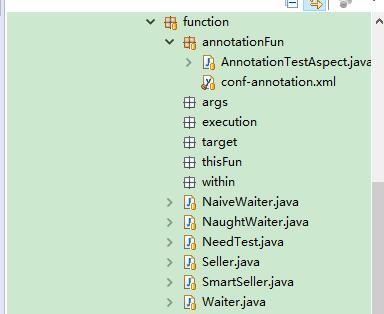@annotation()概述
@annotation表示標注了某個注解的所有方法。
下面通過一個實例說明@annotation()的用法。 AnnotationTestAspect定義了一個后置切面增強,該增強將應用到標注了NeedTest的目標方法中。
實例
代碼已托管到Github—> https://github.com/yangshangwei/SpringMaster

首先我們先自定義一個注解@NeedTest。
如何自定義注解請參考Java-Java5.0注解解讀
|
1
2
3
4
5
6
7
8
9
10
11
12
13
14
15
16
17
18
19
20
21
22
23
24
25
26
|
package com.xgj.aop.spring.advisor.aspectJ.function;import java.lang.annotation.Documented;import java.lang.annotation.ElementType;import java.lang.annotation.Retention;import java.lang.annotation.RetentionPolicy;import java.lang.annotation.Target;/** * * * @ClassName: NeedTest * * @Description: 自定義注解@NeedTest * * @author: Mr.Yang * * @date: 2017年8月26日 下午11:19:12 */// 聲明注解的保留期限@Retention(RetentionPolicy.RUNTIME)// 聲明可以使用該注解的目標類型@Target(ElementType.METHOD)@Documentedpublic @interface NeedTest { // 聲明注解成員 boolean value() default false;} |
下面我們定義接口 Waiter
|
1
2
3
4
5
|
package com.xgj.aop.spring.advisor.aspectJ.function;public interface Waiter { public void greetTo(String clientName); public void serverTo(String clientName);} |
接口實現類 兩個NaiveWaiter 和 NaughtWaiter
|
1
2
3
4
5
6
7
8
9
10
11
12
13
14
15
16
|
package com.xgj.aop.spring.advisor.aspectJ.function;public class NaiveWaiter implements Waiter { @NeedTest(true) @Override public void greetTo(String clientName) { System.out.println("NaiveWaiter:greet to " + clientName); } @Override public void serverTo(String clientName) { System.out.println("NaiveWaiter:server to " + clientName); } public void smile(String clientName, int times) { System.out.println("NaiveWaiter:smile to " + clientName + " " + times + " times"); }} |
|
1
2
3
4
5
6
7
8
9
10
11
12
13
14
15
16
|
package com.xgj.aop.spring.advisor.aspectJ.function;public class NaughtWaiter implements Waiter { @Override public void greetTo(String clientName) { System.out.println("NaughtWaiter:greet to " + clientName); } @NeedTest(true) @Override public void serverTo(String clientName) { System.out.println("NaughtWaiter:server to " + clientName); } public void joke(String clientName, int times) { System.out.println("NaughtyWaiter:play " + times + " jokes to " + clientName); }} |
我們可以看到 NaiveWaiter#greetTo()方法標注了@NeedTest, NaughtWaiter#serverTo()也標注了@NeedTest,我們的目標就是將后置增強織入到這兩個標注了@NeedTest的方法中。
接下來編寫切面的橫切邏輯
|
1
2
3
4
5
6
7
8
9
10
11
12
13
14
15
16
17
18
19
20
21
|
package com.xgj.aop.spring.advisor.aspectJ.function.annotationFun;import org.aspectj.lang.annotation.AfterReturning;import org.aspectj.lang.annotation.Aspect;/** * * * @ClassName: AnnotationTestAspect * * @Description: 切面 、 后置增強 ,@annotation表示標注了某個注解的所有方法 * * @author: Mr.Yang * * @date: 2017年8月26日 下午11:23:53 */@Aspectpublic class AnnotationTestAspect { @AfterReturning("@annotation(com.xgj.aop.spring.advisor.aspectJ.function.NeedTest)") public void needTest() { System.out.println("needTest() executed,some logic is here"); }} |
接下來通過Spring自動應用切面,配置文件如下
|
1
2
3
4
5
6
7
8
9
10
11
12
13
14
15
16
17
18
19
|
<?xml version="1.0" encoding="UTF-8"?><beans xmlns="http://www.springframework.org/schema/beans" xmlns:aop="http://www.springframework.org/schema/aop" xmlns:xsi="http://www.w3.org/2001/XMLSchema-instance" xsi:schemaLocation="http://www.springframework.org/schema/beans http://www.springframework.org/schema/beans/spring-beans.xsd http://www.springframework.org/schema/aop http://www.springframework.org/schema/aop/spring-aop.xsd"><!-- 使用基于Schema的aop命名空間進行配置 --> <!-- 基于@AspectJ切面的驅動器 --><aop:aspectj-autoproxy/> <!-- 目標Bean --><bean id="naiveWaiter" class="com.xgj.aop.spring.advisor.aspectJ.function.NaiveWaiter"/><bean id="naughtWaiter" class="com.xgj.aop.spring.advisor.aspectJ.function.NaughtWaiter"/><!-- 使用了@AspectJ注解的切面類 --><bean class="com.xgj.aop.spring.advisor.aspectJ.function.annotationFun.AnnotationTestAspect"/></beans> |
最后編寫測試代碼:
|
1
2
3
4
5
6
7
8
9
10
11
12
13
14
15
16
17
18
19
20
|
package com.xgj.aop.spring.advisor.aspectJ.function.annotationFun;import org.junit.Test;import org.springframework.context.ApplicationContext;import org.springframework.context.support.ClassPathXmlApplicationContext;import com.xgj.aop.spring.advisor.aspectJ.function.Waiter;public class AnnotationTestAspcetTest { @Test public void test() { ApplicationContext ctx = new ClassPathXmlApplicationContext( "com/xgj/aop/spring/advisor/aspectJ/function/annotationFun/conf-annotation.xml"); // 必須是接口類型,否則拋類型轉換異常 Waiter waiter = (Waiter) ctx.getBean("naiveWaiter"); // 因為greetTo標注了@NeedTest,因此會被后置增強 waiter.greetTo("XiaoGongJiang"); waiter.serverTo("XiaoGongJiang"); Waiter naughtWaiter = (Waiter) ctx.getBean("naughtWaiter"); // serverTo標注了@NeedTest,因此會被后置增強 naughtWaiter.serverTo("XiaoGongJiang"); }} |
運行結果:
2017-08-27 01:24:22,551 INFO [main] (AbstractApplicationContext.java:583) - Refreshing org.springframework.context.support.ClassPathXmlApplicationContext@6ac604: startup date [Sun Aug 27 01:24:22 BOT 2017]; root of context hierarchy
2017-08-27 01:24:22,647 INFO [main] (XmlBeanDefinitionReader.java:317) - Loading XML bean definitions from class path resource [com/xgj/aop/spring/advisor/aspectJ/function/annotationFun/conf-annotation.xml]
NaiveWaiter:greet to XiaoGongJiang
needTest() executed,some logic is here
NaiveWaiter:server to XiaoGongJiang
NaughtWaiter:server to XiaoGongJiang
needTest() executed,some logic is here
從輸出結果中可以看出,切面被正確的織入到了標注有@NeedTest注解的方法中。
以上為個人經驗,希望能給大家一個參考,也希望大家多多支持服務器之家。
原文鏈接:https://artisan.blog.csdn.net/article/details/77619875













